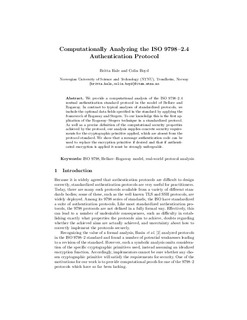Computationally Analyzing the ISO 9798-2.4 Authentication Protocol
Chapter
Accepted version

Åpne
Permanent lenke
http://hdl.handle.net/11250/2483747Utgivelsesdato
2014Metadata
Vis full innførselSamlinger
Sammendrag
We provide a computational analysis of the ISO 9798–2.4 mutual authentication standard protocol in the model of Bellare and Rogaway. In contrast to typical analyses of standardized protocols, we include the optional data fields specified in the standard by applying the framework of Rogaway and Stegers. To our knowledge this is the first application of the Rogaway–Stegers technique in a standardized protocol. As well as a precise definition of the computational security properties achieved by the protocol, our analysis supplies concrete security requirements for the cryptographic primitive applied, which are absent from the protocol standard. We show that a message authentication code can be used to replace the encryption primitive if desired and that if authenticated encryption is applied it must be strongly unforgeable.